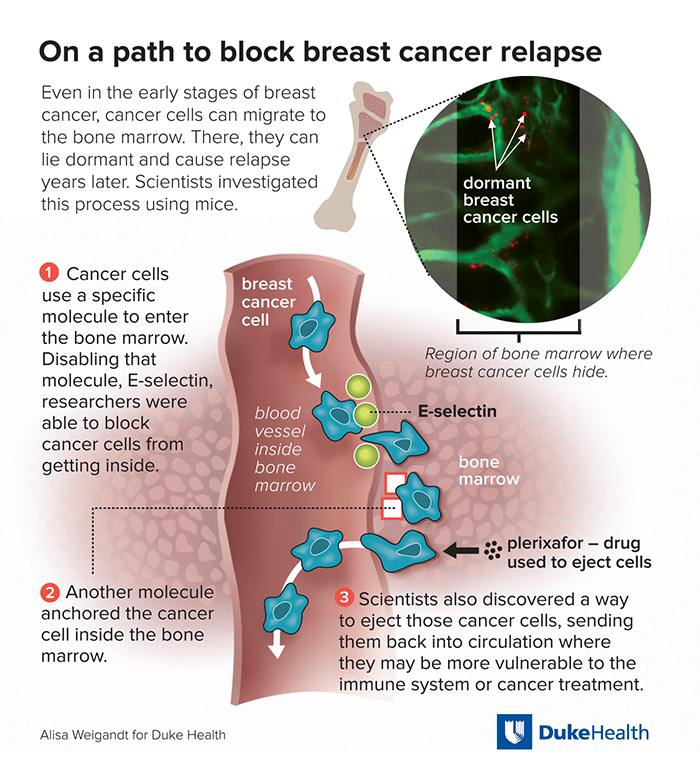
Mouse Study Illuminates the Spread of Breast Cancer to Bone
July 7, 2016, by NCI Staff
By tracking the spread of breast cancer cells in mice, researchers have identified two proteins that may regulate the movement of breast cancer cells into and out of bone marrow.
A protein called E-selectin may allow breast cancer cells to enter certain regions of the bone marrow, and another protein, CXCR4, may help breast cancer cells remain within the bone, according to the study results.
The findings may provide a “molecular framework” for understanding the spread, or metastasis, of breast cancer cells to bone, Trevor Price, Ph.D., of the Duke Cancer Institute and his colleagues wrote in Science Translational Medicine on May 25. The researchers also suggested that the findings could lead to new strategies for preventing and treating bone metastases in women with breast cancer.
Exploring Mechanisms of Metastasis
In humans, breast cancer can recur in patients more than a decade after the disease has been treated. In most of these cases, the cancer has metastasized to bone.
“Our study addresses a difficult clinical problem—the disease can recur in patients who thought they had been cured of breast cancer years earlier,” explained Dorothy A. Sipkins, M.D., Ph.D., of the Duke Cancer Institute, who led the research.
Past work had suggested that these late recurrences may be caused by the emergence of breast cancer cells that had previously spread to the bone—known as micrometastases—but had remained dormant. But the mechanisms involved in the spread of breast cancer to bone are poorly understood.
E-selectin is an adhesion protein—a protein that helps cells bind to other cells and to their surroundings—that is present on the surfaces of cells lining blood vessels. Because the protein has been associated with the homing of hematopoietic stem cells into the bone marrow at certain regions, or niches, where it is highly expressed, the researchers investigated whether breast cancer cells could co-opt E-selectin to also mediate their movement into the bone.
Using a technique known as high-resolution, real-time microscopy, the investigators followed the movements of individual breast cancer cells in mice containing human breast cancer cells that metastasize to bone. “This technology allows us to visualize the breast cancer cells within the bone marrow and can get down to a single-cell resolution,” explained Dr. Price.
The researchers found that breast cancer cells express multiple proteins that may bind to E-selectin. Through experiments with mice, the researchers showed that breast cancer cells spread preferentially to blood vessels that expressed E-selectin and that interactions between the breast cancer cells and E-selectin allowed the breast cancer cells to enter bone.
“E-selectin is a sticky protein expressed by certain blood vessels that serves as a portal into the bone marrow,” explained Cynthia Dunbar, M.D., of the Hematology Branch at the National Heart, Lung, and Blood Institute, who was not involved in the research. “The bone marrow seems to provide a protective home for breast cancer cells.”
The cells traveled to specific areas within the bone marrow known as perisinusoidal vascular regions, the researchers found. These niches may be “a protective haven against chemotherapy,” the authors wrote. Once inside the bone marrow, the breast cancer cells may remain there for extended periods of time and be protected from attack by chemotherapy and other treatments.
The researchers then showed that the receptor protein CXCR4 may help to anchor breast cancer cells within the bone marrow. When they exposed the mice to a drug called plerixafor (Mozobil®), which blocks the CXCR4 receptor and is used to mobilize stem cells into the bloodstream so they can be harvested for stem cell transplants, some dormant breast cancer cells were forced out of the bone marrow.
In additional experiments, the researchers used an E-selectin inhibitor, called GMI-1271, to prevent some breast cancer cells circulating in the bloodstream from entering the bone marrow. This drug is already being evaluated in human clinical trials for leukemia and multiple myeloma as a way to push tumor cells out of the bone marrow into the blood, where they might be killed more easily by chemotherapy, according to Dr. Dunbar.
“These findings suggest that combining a CXCR4 inhibitor to force the cells out of their niches and an E-selectin inhibitor to prevent metastasis to the bone marrow could help trap the cells in the vasculature, where they could be killed with chemotherapy,” noted the editors of Science Translational Medicine in a summary accompanying the article.
Focusing on Next Steps
The researchers will continue to investigate the mechanisms uncovered in this study using the mouse model and tissue from patients with breast cancer. “We are interested in seeing whether disconnecting breast cancer cells from an environment that harbors them in a clinically dormant state could expose the vulnerabilities of these cells,” said Dr. Sipkins.
Future studies, added Dr. Price, will also look at what happens to breast cancer cells that are mobilized out of the bone marrow.
More research is needed to ensure that breast cancer cells forced out of the bone marrow do not travel through the bloodstream to another organ, such as the brain, noted Dr. Dunbar. The current study, she continued, will inform the direction of future research.
“The more we know about how breast cancer cells spread to bone, the more we will be able to explore ways to prevent and treat bone metastases,” she said.























.png)











No hay comentarios:
Publicar un comentario